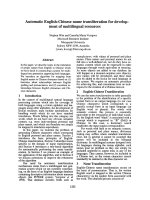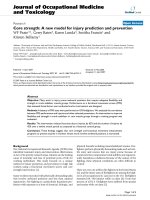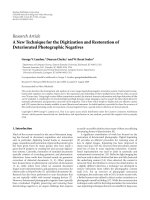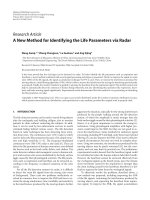Báo cáo y học: " Histone deacetylases — a new target for suppression of cartilage degradation" pdf
Bạn đang xem bản rút gọn của tài liệu. Xem và tải ngay bản đầy đủ của tài liệu tại đây (37.69 KB, 2 trang )
155
ADAMTS = a disintegrin and metalloproteinase with thrombospondin motifs; bp = base pairs; HDAC = histone deacetylase; MMP = matrix metallo-
proteinase; TIMP = tissue inhibitor of metalloproteinases.
Available online />Abstract
Increased expression of metalloproteinases is a fundamental aspect
of arthritis pathology and its control is a major therapeutic objective.
In cartilage cultured in the presence of the cytokines interleukin-1
and oncostatin M, chondrocytes produce enhanced levels of
metalloproteinases of the ADAMTS (a disintegrin and
metalloproteinase with thrombospondin motifs) and MMP (matrix
metalloproteinase) families, resulting in the degradation of aggrecan
and collagen. The histone deacetylase inhibitors trichostatin A and
butyrate were shown to drastically reduce expression of these
enzymes relatively selectively, with concomitant inhibition of
breakdown of matrix components. This family of enzymes is
therefore a promising target for therapeutic intervention.
Proteolytic activity in articular cartilage is central to joint
destruction in arthritis. Proteinase expression is well known to
be modulated by cytokines, intracellular signaling, and
transcription factor action, but recent work by Young and
colleagues [1] indicates that there is significantly more to this
process than has been generally believed.
The human genome is packed in a matrix of histones that
shield it from transcription by RNA polymerase II. The basic
unit of chromatin is the nucleosome core particle, which
consists of 147 bp of DNA wound 1.7 times around a histone
octamer composed of two copies each of four histone
partners (H2A, H2B, H3, and H4). The core particles are
separated by a 10- to 60-bp linker region and the resulting
‘beads-on-a-string’ are further condensed into thicker fibers,
which make up chromatin [2].
While structural studies suggested the nucleosome to be a
stable particle, it is now clear that in vivo it is much more
dynamic [3]; histone units can be exchanged and the whole
complex is able to slide along the DNA in an ATP-dependent
mechanism through the action of members of the Swi2/Snf2
family of ATPases. In addition to a conserved globular core
protein region, each histone molecule contains an N-terminal
tail rich in basic residues, which project beyond the
surrounding DNA. In the case of H3 and H4, specific lysine
sidechains undergo acetylation, through the action of histone
acetyltransferases, by way of acetyl coenzyme A, a step
which is associated with transcriptional activation. These
modifications can be reversed by histone deacetylases
(HDACs), of which there are four families [4].
Three of the families (I, II, and IV) are zinc-dependent enzymes,
catalytically resembling the metalloproteinases, but family III
(the recently discover SIR2 enzymes) uses a completely
different mechanism depending on NAD
+
(oxidized
nicotinamide-adenine dinucleotide) as a cofactor [5]. The
members of family II are of particular importance because they
are modular proteins with binding domains for protein–protein
interaction with, among others, transcription factors.
The specific roles of various HDACs have been investigated
by gene deletion in mice. Of special interest with regard to
cartilage and bone development is the recently determined
phenotype of the HDAC4-null animals [6]. HDAC4 is
expressed in prehypertrophic chondrocytes and interacts
with the key transcription factor Runx2 (also termed Cbfa1).
The null animals develop ectopic calcification and early-onset
chondrocyte hypertrophy, as is also seen in mice
constitutively expressing Runx2. Conversely, mice over-
expressing HDAC4 in cartilage show greatly reduced
chondrocyte hypertrophy, similar to that in the Runx2-null
phenotype.
Commentary
Histone deacetylases — a new target for suppression of cartilage
degradation?
John S Mort
Shriners Hospital for Children; and Department of Surgery, McGill University; Montreal, Quebec, Canada
Corresponding author: John S Mort,
Published: 16 June 2005 Arthritis Research & Therapy 2005, 7:155-156 (DOI 10.1186/ar1781)
This article is online at />© 2005 BioMed Central Ltd
See related research by Young et al., />156
Arthritis Research & Therapy August 2005 Vol 7 No 4 Mort
In a more general way, the role of the HDACs can be
investigated using inhibitors. HDACs of families I, II, and IV
are inhibited by hydroxamate derivatives such as the natural
product trichostatin A [7]. Although at the moment such
HDAC inhibitors show little specificity for individual HDAC
family members [8], efforts have been made to develop
specific small-molecule inhibitors, and various compounds
are currently in clinical trials for various forms of cancer [9].
Butyrate has long been known to be an effective HDAC
inhibitor and is currently in phase II clinical trials [9]. Initial
evidence also points to the use of HDAC inhibitors in
inflammatory arthritis [10,11].
HDACs show a varied tissue distribution, and mapping of
cartilage transcripts shows evidence for expression of many
HDACs in this tissue [12]. The recent work from Young and
colleagues [1] shows the effective use of HDAC inhibitors for
decreasing metalloproteinase expression in cartilage and
demonstrates that the paradigm of inhibition of histone
deacetylation leading to gene silencing is not absolute.
Cawston and colleagues showed many years ago that
cartilage cultured in the presence of a mixture of the
cytokines interleukin-1 and oncostatin M undergoes rapid
aggrecan loss followed later by collagen degradation and the
release of degraded collagen fragments into the medium
[13]. These degradative processes have been attributed to
the action of specific ADAMTS (a disintegrin and metallo-
proteinase with thrombospondin motifs) family members and
matrix metalloproteinase 13 (MMP13 or collagenase 3),
respectively. Addition of either trichostatin A or butyrate
resulted in a dramatic reduction of glycosaminoglycan loss
(aggrecan degradation) and collagen release. These
processes are associated with decreased levels of ADAMTS-
4 and -5 and of MMP13, respectively, and message levels of
these gene products were correspondingly reduced as
determined by real-time polymerase chain reaction. In
contrast, expression of the major cartilage structural
molecules aggrecan and type II collagen and a number of
other metalloproteinases was unaffected by the presence of
the inhibitors. The findings using bovine nasal cartilage were
reinforced by cell culture studies using a human chondro-
sarcoma cell line and primary human chondrocytes.
In a second paper [14], Young and colleagues address the
other side of metalloproteinase action, the expression of the
inhibitor TIMP (tissue inhibitor of metalloproteinases). Here
they show that HDAC inhibitors have opposing effects on
TIMP-1 expression, depending on whether phorbol ester or
transforming growth factor β is used for induction, with the
latter showing an impressive repression with HDAC inhibitors
whereas the phorbol ester increases TIMP-1 expression.
Conclusion
Both of these studies by Young and colleagues [1,14]
suggest the potential for HDAC inhibitors in the control of
cartilage catabolism and demonstrate that more work is
required to understand the molecular mechanisms underlying
their action and in the regulation of these enzymes.
Competing interests
The author(s) declare that they have no competing interests.
References
1. Young DA, Lakey RL, Pennington CJ, Jones D, Kevorkian L,
Edwards DR, Cawston TE, Clark IM: Histone deacetylase
inhibitors modulate metalloproteinase gene expression in
chondrocytes and block cartilage resorption. Arthritis Res Ther
2005, 7:R503-R512.
2. Peterson CL, Laniel MA: Histones and histone modifications.
Curr Biol 2004, 14:R546-R551.
3. Längst G, Becker PB: Nucleosome remodeling: one mecha-
nism, many phenomena? Biochim Biophys Acta 2004, 1677:
58-63.
4. Sengupta N, Seto E: Regulation of histone deacetylase activi-
ties. J Cell Biochem 2004, 93:57-67.
5. Marmorstein R: Structure and chemistry of the Sir2 family of
NAD
+
-dependent histone/protein deacetylases. Biochem Soc
Trans 2004, 32:904-909.
6. Vega RB, Matsuda K, Oh J, Barbosa AC, Yang X, Meadows E,
McAnally J, Pomajzl C, Shelton JM, Richardson JA: Histone
deacetylase 4 controls chondrocyte hypertrophy during skele-
togenesis. Cell 2004, 119:555-566.
7. Yoshida M, Kijima M, Akita M, Beppu T: Potent and specific inhi-
bition of mammalian histone deacetylase both in vivo and in
vitro by trichostatin A. J Biol Chem 1990, 265:17174-17179.
8. de Ruijter AJ, van Gennip AH, Caron HN, Kemp S, van Kuilenburg
AB: Histone deacetylases (HDACs): characterization of the
classical HDAC family. Biochem J 2003, 370:737-749.
9. Monneret C: Histone deacetylase inhibitors. Eur J Med Chem
2005, 40:1-13.
10. Nishida K, Komiyama T, Miyazawa S, Shen ZN, Furumatsu T, Doi
H, Yoshida A, Yamana J, Yamamura M, Ninomiya Y, et al.: Histone
deacetylase inhibitor suppression of autoantibody-mediated
arthritis in mice via regulation of p16INK4a and
p21(WAF1/Cip1) expression. Arthritis Rheum 2004, 50:3365-
3376.
11. Chung YL, Lee MY, Wang AJ, Yao LF: A therapeutic strategy
uses histone deacetylase inhibitors to modulate the expres-
sion of genes involved in the pathogenesis of rheumatoid
arthritis. Mol Ther 2003, 8:707-717.
12. Yager TD, Dempsey AA, Tang H, Stamatiou D, Chao S, Marshall
KW, Liew CC: First comprehensive mapping of cartilage tran-
scripts to the human genome. Genomics 2004, 84:524-535.
13. Cawston TE, Ellis AJ, Humm G, Lean E, Ward D, Curry V: Inter-
leukin-1 and oncostatin M in combination promote the
release of collagen fragments from bovine nasal cartilage.
Biochem Biophys Res Commun 1995, 215:377-385.
14. Young DA, Billingham O, Sampieri CL, Edwards DR, Clark IM:
Differential effects of histone deacetylase inhibitors on
phorbol ester- and TGF-
ββ
1 induced murine tissue inhibitor of
metalloproteinases-1 gene expression. FEBS J 2005, 272:
1912-1926.









